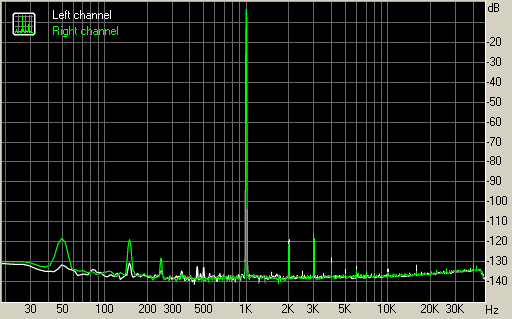Introduction
A couple of years ago, I bought a HK-DAC with Cirrus Logic CS4397 chip. This DAC was modified and measured in this article. It works fine for years already, but the HK-DAC had a couple of disadvantages (like it only had 2 inputs), so I decided to design a DAC pcb myself with some more flexibility. Apart from the output filter it is based straightforward on the datasheets.
Features
- CS8416 receiver chip
- CS4398 DAC chip
- Using the DAC-interface it can be extended with different DAC types (both voltage/current out types)
- 2 optical inputs
- 2 coaxial inputs with pulse transformer
- Extension room for external input instead of 1 coax, e.g. USB
- Supports both hardware AND software mode, so it can be used both standalone and controlled from a microcontroller
- HW Control interface (input select, reset, NVERR)
- SW Control interface (SPI)
- Butterworth 2nd order output filter
- Needed supply: Dual 7-12V analog, 5V digital
Mounting layout
This project is very versatile, as the DAC can be controlled in software mode using a microcontroller. The most common way to use it though is in hardware mode. This picture shows the components that are needed and how they need to be wired.
To build a complete DAC in hardware mode requires:
- A Cabinet
- CS4398 DAC kit
- TripleRegulated supply kit
- 1x Power connector
- 1x Power switch
- 2x Insulated cinch connector (black+red)
- 1x LED for error feedback
- 2x Switch for selecting the input
- 1x 6-pin KK-2.54mm connector (HW-CTRL)
- 1x 3-pin KK-2.54mm connector (Analog output)
The complete DAC can be built for about 100 euros. The kit can be ordered with SMD components pre-mounted, which makes it a very good beginner project!
Schematic
The schematic of the DAC is quite straightforwardly obtained from the datasheets of the CS8416 and CS4387 chips. The CS8416 s/pdif receiver has 4 inputs (in HW mode), which are connected to the 2 optical and 2 coaxial inputs. The optical inputs use a Sharp GP1FAV50 optical receiver. The coaxial inputs have a PE-65612NL pulse transformer for separating the coaxial inputs from the pcb. By connecting RXSEL0 and RXSEL1 on HWCTRL to either 5V or GND, one of the inputs on the CS8416 can be selected. From the digital 5V, two separate 3.3V are derived for the input and digital side of the CS8416 to achieve highest possible jitter rejection. By connecting SDOUT with a 47k resistor to GND, the HW mode is selected. For both the CS8416 and CS4398 I2S mode is selected (using R25-R30 and M0-M3), with CS4398 in Dual speed mode, allowing inputs from 44.1kHz to 192kHz to be handled. Furthermore plenty of decoupling and filtering caps and inductors are used to provide clean supply for the different ICs.
The output filter is DC-coupled around an OPA2134PA (IC2). As the OPA2134PA has FET inputs and is used in differential mode, the output DC voltage will be small. The selected components are used to form a symmetrical 2nd order Butterworth filter. With the chosen component values, a voltage gain of 2 is obtained. The crossover frequency is 50kHz. With the CS4398 being able to output about 2Vpp, the analog output will therefore be max 8Vpp.
Proposed supply
Above, a proposed supply for the DAC is shown, which has separate dual analog and single digital supply. It is available in the webshop as TripleRegulated_EI38. A bridge rectifier with snubber caps is used to rectify the transformer output. Electrolytic capacitors C2, C3 and C9 are used to smooth the output voltage, before it is regulated by LM317/LM337. The output voltage can be selected using different values for resistors R2, R3 and R6. Note that the measurements below are done with this supply.
Measurements
The proof of the pudding is in the eating...RMAA measurements have been done with my EMU 1212m soundcard. The soundcard coax/optical output are connected to the DAC input, the analog DAC output is connected to the soundcard analog input and a loopback test is done. Test results below are done with the optical input at 96kHz, but results are similar for 48kHz or for coaxial input.
Summary
| Frequency response (from 40 Hz to 15 kHz), dB |
+0.01, -0.08
|
Excellent
|
| Noise level, dB (A) |
-107.3
|
Excellent
|
| Dynamic range, dB (A) |
107.4
|
Excellent
|
| THD, % |
0.0003
|
Excellent
|
| THD + Noise, dB (A) |
-100.4
|
Excellent
|
| IMD + Noise, % |
0.0014
|
Excellent
|
| Stereo crosstalk, dB |
-102.3
|
Excellent
|
| IMD at 10 kHz, % |
0.0015
|
Excellent
|
| General performance |
Very good
|
The measurements show that the DAC performance is very high, in fact the analog input of the EMU 1212m sound card is becoming the limiting factor for the measurements. So I am very pleased with the results. Below are plots of frequency response and total harmonic distortion.
Frequency response

Total harmonic distortion

Complete measurement report can be found here.
Conclusions
Both measurement results and listening tests show that this is a very low distortion DAC. It reveals lots of details and makes listening to my music collection a renewed experience.
More information on different ways to use this circuit can be found on the PreAmplifier project page. There it is used in software mode, which adds a couple of convenient features, like control of the volume, DAC parameters, read input bitdepth and frequency.
User gallery
This section contains images of users who actually built this DAC.
Djuke
My first prototype, built inside a small cabinet.
BenJ
Built inside a slightly larger cabinet as my prototype, including printed front panel!
Wimshurst
DAC with a small additional circuit on veroboard that switches an output relay using the DAC error signal to mute the outputs when no signal (or an error) is detected. Also a Cmoy headphone amplifier with OPA2134 is added.

























